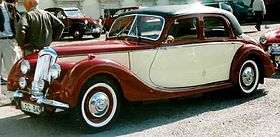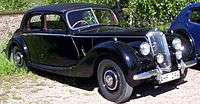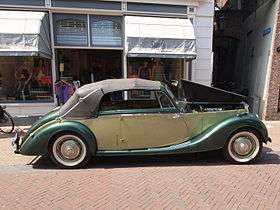Riley RM
| Riley RM Series | |
|---|---|
| Overview | |
| Manufacturer | Riley |
| Production | 1945–55 |
| Body and chassis | |
| Class | Executive car (E) |
| Body style |
|
| Layout | FR layout |
| Dimensions | |
| Wheelbase |
1.5 L cars – 112 in (2,845 mm) 2.5 L cars – 119 in (3,023 mm) |
| Length |
1.5 L cars – 179 in (4,547 mm) 2.5 L cars – 186 in (4,724 mm) |
| Width | 63 in (1,600 mm) |
| Height | 59 in (1,499 mm) |
| Chronology | |
| Predecessor |
|
| Successor | Riley Pathfinder |
The Riley RM Series is an executive car which was produced by Riley from 1945 to 1955. It was the last model developed independently by Riley prior to the 1952 merger of Riley's still new owner Nuffield, with Austin to form BMC. The RM series was originally produced in Coventry, but in 1949 production moved to the MG works at Abingdon. The RM models were marketed as the Riley 1½ Litre and the Riley 2½ Litre.[1]
There were three types of RM vehicles produced. The RMA was a large saloon, and was replaced by the RME. The RMB was a longer car to carry the larger engine and was replaced by the RMF. The RMC and RMD were limited-production cars, an open 2 or 3-seater and a 4-seater cabriolet. All of the RM vehicles featured the pre-war Riley race developed 1.5 L (1496 cc) 12 hp (RAC Rating) or the successful 1937 new 16 hp (RAC Rating) 2.5 L "Big Four" straight-4 engines with hemispherical combustion chambers and twin camshafts mounted high at the sides of the cylinder block.
Kestrel
_(18751537161).jpg)
The RM was a face-lift of their pre-war 1½ or 2½ Litre Kestrel.
Riley RMA
| Riley RMA | |
|---|---|
.jpg) manufactured 1952 | |
| Overview | |
| Production |
1945–52 10,504 produced. |
| Body and chassis | |
| Body style | 4-door saloon |
| Powertrain | |
| Engine | 1.5 L Straight-4 as for 2½-litre Big Four but bore 69mm by stroke 100mm and bhp 60 @5,300 rpm[2] |
| Chronology | |
| Predecessor | Riley 12/4 and Riley 12 |
| Successor | Riley RME |
The RMA was the first post-war Riley. It was announced in August 1945 with the news it would become available in the autumn.[3] It used the 1.5 L engine and was equipped with hydro-mechanical brakes and an independent suspension using torsion bars in front. The body frame (not to be confused with the chassis) was made of wood in the English tradition, and the car featured traditional styling. The car was capable of reaching 75 mph (121 km/h). The RMA was produced from 1945 until 1952 when it was replaced by the RME.
 Riley RMA 1½-Litre 4-Door Saloon 1949
Riley RMA 1½-Litre 4-Door Saloon 1949 Riley RMA 1½-Litre 4-Door Saloon 1952
Riley RMA 1½-Litre 4-Door Saloon 1952
| Wikimedia Commons has media related to Riley 1½ RMA saloon. |
Riley RMB
| Riley RMB | |
|---|---|
 | |
| Overview | |
| Production |
1946–52 6900 produced |
| Body and chassis | |
| Body style | 4-door saloon |
| Powertrain | |
| Engine | 2.5 L Straight-4 |
| Dimensions | |
| Wheelbase | 119 in (3,023 mm)[4] |
| Length | 186 in (4,724 mm)[4] |
| Width | 63.5 in (1,613 mm)[4] |
| Height | 59 in (1,499 mm)[4] |
| Chronology | |
| Successor | Riley RMF |
The 2.5 L (2443 cc) RMB was a lengthened RMA launched a year later in 1946.
It used the 2.5 L (2443 cc) "Big Four" engine with twin SU carburettors, starting with 90 hp (67 kW) but increasing to 100 hp (75 kW) for 1948 with a 95 mph (153 km/h) top speed.
The wheelbase was 6.5 in (165 mm) longer and the overall length was a full 7 in (178 mm) longer. The RMB was replaced by the RMF for 1952.
A car tested by The Motor magazine in 1949 had a top speed of 90 mph (140 km/h) and could accelerate from 0–60 mph (97 km/h) in 16.8 seconds. A fuel consumption of 19.6 miles per imperial gallon (14.4 L/100 km; 16.3 mpg-US) was recorded. The test car cost £1224 including taxes.[4]
 Riley RMB 2½-Litre 4-Door Saloon 1949
Riley RMB 2½-Litre 4-Door Saloon 1949 Riley RMB 2½-Litre 4-Door Saloon 1950
Riley RMB 2½-Litre 4-Door Saloon 1950
| Wikimedia Commons has media related to Riley 2½ RMB saloon. |
Riley RMC
| Riley RMC | |
|---|---|
|
manufactured 1949 | |
| Overview | |
| Production |
1948–51 507 produced |
| Body and chassis | |
| Body style | 2-door open 2/3-seater |
| Powertrain | |
| Engine | 2.5 L Straight-4 |
The RMC (coupé) was an open 2-door, single bench seat, 2/3-seater version of the RMB with a large rear deck area and fold flat windscreen.
Without side windows it was supplied with flexible celluloid-glazed side curtains with a hole for hand signals and, when deployed, flimsy synthetic roofing over a light metal frame. It shared that car's 2.5 L 100 hp (75 kW) engine and could reach 100 mph (161 km/h).
The car was primarily designed for the North American export market, and just over 500 were built from 1948 until 1951. The gear change lever was moved to the steering column on left-hand-drive models.
.jpg) 1948 in Canada
1948 in Canada.jpg) 1949 in USA
1949 in USA
There is a remarkable likeness to a 1934 Ford V8 Back and Front
Riley RMD
| Riley RMD | |
|---|---|
 manufactured 1950 | |
| Overview | |
| Production |
1949–51 502 produced |
| Body and chassis | |
| Body style | 2-door cabriolet |
| Powertrain | |
| Engine | 2.5 L Straight-4 |
The RMD (drophead) was a traditional 2-door cabriolet, the last cabriolet to wear the Riley name. It used the same 2.5 L 100 hp (75 kW) engine as the RMB, on which it was based. Just over 500 were produced between 1949 and 1951.
 dropped cabriolet head A motor car that is a cabriolet has fixed sides to its roof known as cant rails and a folding top that remains part of the vehicle. In a cabriolet like this Riley RMD the tops of the fixed sides, the cant rails, the beams over the side-windows, may be folded along with the top. While the hood is being opened or closed the heavy cant rail beams are supported by exterior hood irons. The hood irons, an elongated S-shape when the roof is up, may be seen at each of the roof’s rear quarters. A more English name for a folding cover or canopy of a (horse drawn) vehicle enabling the occupants to be seen clearly is a "head" or for motor vehicles in the mid-20th century drop head.[5] |
 Riley RMD 2½-Litre Drophead Coupé 1950
Riley RMD 2½-Litre Drophead Coupé 1950 Riley RMD 2½-Litre Drophead Coupé 1950
Riley RMD 2½-Litre Drophead Coupé 1950 Riley RMD 2½-Litre Drophead Coupé 1952
Riley RMD 2½-Litre Drophead Coupé 1952
Riley RME
| Riley RME | |
|---|---|
 first registered July 1953 | |
| Overview | |
| Production |
1952–55 3446 produced |
| Body and chassis | |
| Body style | 4-door saloon |
| Powertrain | |
| Engine | 1.5 L Straight-4 |
| Chronology | |
| Predecessor | Riley RMA |
| Successor | Riley One-Point-Five (1957) |
The RME was an updated RMA. It still used the 1.5 L four and featured a fully hydraulic braking system. The body had an enlarged rear window with curved glass.To improve acceleration the rear axle ratio was changed from 4.89:1 to 5.125:1.[6]
When the 2.5 L (2443 cc) car ended production in October 1953 a switch to no running boards was amongst many updates to the RME including wholly new shaped front mudguards.
Produced from 1952, it was discontinued in 1955 and ultimately its place in the range went in 1957 to the much shorter and unrelated, intended but unused, replacement for the Morris Minor — Riley One-Point-Five also sold as Wolseley 1500) and Morris Major).
An RME tested by The Motor magazine in 1952 had a top speed of 75 mph (121 km/h) and could accelerate from 0–60 mph (97 km/h) in 29.5 seconds. A fuel consumption of 24.2 miles per imperial gallon (11.7 L/100 km; 20.2 mpg-US) was recorded. The test car cost £1,339 including taxes.[6]

 Riley RME 1½-Litre 4-Door Saloon
Riley RME 1½-Litre 4-Door Saloon
Riley RMF
| Riley RMF | |
|---|---|
.jpg) first registered March 1953 | |
| Overview | |
| Production |
1952–53 1050 produced |
| Body and chassis | |
| Body style | 4-door saloon |
| Powertrain | |
| Engine | 2.5 L Straight-4 |
| Chronology | |
| Predecessor | Riley RMB |
| Successor | Riley Pathfinder |
The RMF replaced the RMB in 1952. It shared that car's 2.5 L "Big Four" engine as well as the mechanical updates from the RME. The RMH Riley Pathfinder, the last automobile to use the Riley "Big Four" engine, and thus considered to be the last "real" Riley by purists, took its place after 1953 and continued in production until 1957.
| Riley 2½-litre Big Four | |
|---|---|
| Overview | |
| Manufacturer | Riley Motors Limited |
| Also called | Riley 16 h.p.[7] |
| Production | 1937 to 1957[8] |
| Combustion chamber | |
| Configuration | straight four |
| Displacement | 2.443 L (149.1 cu in)[8] |
| Cylinder bore | 80.5 mm (3.17 in)[8] |
| Piston stroke | 120 mm (4.7 in)[8] |
| Cylinder block alloy | cast iron, aluminium sump, alloy pistons |
| Cylinder head alloy | cast iron, hemispherical combustion chambers, spark plugs in centre between valve covers[7] |
| Valvetrain | 90-degree angled overhead valves[8] operated by twin high-lift camshafts moving rockers with short light stiff push-rods powered from the crankshaft by duplex roller chains[7] |
| Compression ratio | 6.9 : 1[8] |
| Combustion | |
| Fuel system | Twin H4 SU carburettors[8] mechanical petrol pump[7] |
| Fuel type | petrol |
| Oil system | pressure fed from sump by submerged gear-type pump driven by skew gear from camshaft |
| Cooling system | water, thermostatically controlled flow, belt-driven water pump and radiator fan[7] |
| Output | |
| Power output |
106 bhp @ 4,500 rpm Tax rating 16hp[8] |
| Chronology | |
| Predecessor | none before 1937 |
| Successor | Riley RMH then BMC C-Series engine |
Riley RM Club
A Riley RM Club exists which offers support and a spares service for Riley RMs and Pathfinders.[9]
Scale models
- Meccano Dinky Toys; No. 40a (production 1947–55), Riley Saloon, approximately O scale (1:44).[10]
References
- ↑ Riley advertisements 1931 – 1955, www.car-brochures.eu Retrieved on 7 February 2013
- ↑ Cars of To-Day. The Times, Tuesday, 24 November 1936; pg. 12; Issue 47540
- ↑ City Notes. The Times, Friday, Aug 24, 1945; pg. 7; Issue 50229
- 1 2 3 4 5 "The Riley 2.5-litre Road Test". The Motor. 1949.
- ↑ OED Online. Oxford University Press, December 2015. Web. 13 January 2016.
- HEAD
- CABRIOLET
- 1 2 "The Riley 1.5 Litre Road Test". The Motor. 10 December 1952.
- 1 2 3 4 5 Cars of To-Day. '’’The Times'’, Tuesday, 16 March 1937; pg. 22; Issue 47634.
- 1 2 3 4 5 6 7 8 Rileyrob. "Healey Silverstone (1949–51)". Retrieved 31 January 2014.
- ↑ Riley RM Club
- ↑ Ramsey, John. The Swapmeet and Toyfair Catalogue of British Diecast Model Toys. Swapmeet Toys and Models Ltd. p. 29. ISBN 095093190X.
- A-Z of Cars 1945–1970. Michael Sedgwick and Mark Gillies. Bayview Books. 1989. ISBN 1-870979-39-7